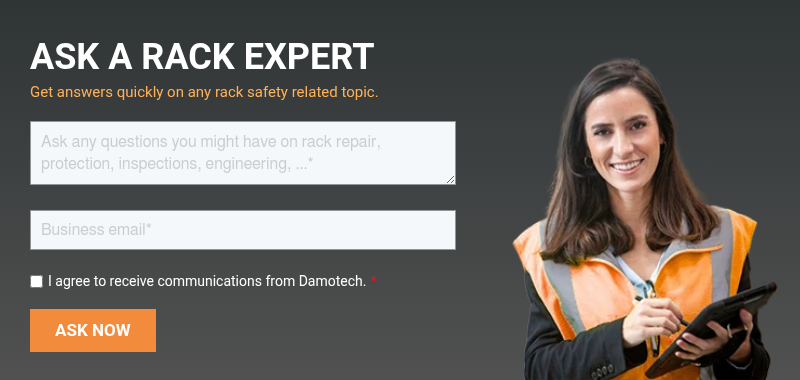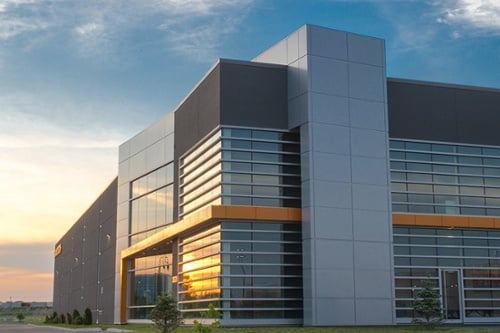What’s the best logistics model for warehouse rack safety? Choosing the best warehouse logistics strategy isn’t just about speed or cost—it has real consequences on pallet rack stress, safety zones, and infrastructure risk.
Cross-docking minimizes racking but increases collision risk. Warehousing stresses rack systems with heavy loads and reconfiguration. Transloading introduces forklift and crane impact risk.
The best strategy depends on throughput, rack usage, and safety infrastructure. Damotech recommends aligning your logistics model with a proactive rack safety plan.
Introduction: More Than Logistics — A Structural Safety Decision
Today’s warehouse managers must do more than manage product flow—they must protect people, equipment, and infrastructure. The core logistics model you choose directly affects pallet rack stress, traffic flow, and overall safety.
This article compares cross-docking, warehousing, and transloading through a new lens: how each strategy shapes warehouse infrastructure and the risks Damotech solutions can solve.
👉 For quick answers to common questions, skip ahead to the FAQ section at the end of this article.
Key Definitions and Operational Footprints
A. Cross-Docking: Velocity-First Flow
Definition: Goods are unloaded from inbound vehicles and immediately transferred to outbound vehicles without long-term storage.
Safety Impact: Minimal racking use, but high collision risks near docks.
Damotech Solution: Install Damo Frame Guard at dock ends and use Damotech Software for risk tracking.
Real-World Cross-Docking Examples:
- Walmart: Their regional distribution centers use pre-distribution cross-docking to replenish stores with high-velocity SKUs daily.
- Amazon: Leverages cross-docking for Prime-eligible items, enabling 24-hour delivery from inbound staging to outbound dispatch.
- Grocery Retailers: Use continuous cross-docking for perishables (e.g., dairy and produce) to minimize spoilage risk.
B. Warehousing: Strategic Storage
Definition: Products are stored and picked over time in structured racking systems.
Safety Impact: Beam overloads, reconfiguration errors, and long-term wear.
Damotech Solution: Annual inspections, load plaques, and engineered rack repair kits.
C. Transloading: Intermodal Transfer Zones
Definition: Goods move between modes (e.g., rail to truck) with potential temporary storage.
Safety Impact: Heavy equipment usage, irregular rack wear.
Damotech Solution: Engineering services for seismic or high-impact zones, protection units.
Side-by-Side Comparison: Logistics Strategies
| Strategy | Rack Usage | Common Safety Risks | Recommended Damotech Solutions |
|---|---|---|---|
| Cross-Docking | Minimal staging | Dock collisions, speed-related hits | Dock guards, Damotech Platform |
| Warehousing | High-density use | Beam overloads*, misloading, reconfiguration | Inspections, load plaques, Damo Pro repair kits |
| Transloading | Heavy equipment | Forklift/crane strikes, zone stress | Structural audit, protection solutions |
*According to ANSI MH16.1, any changes to pallet rack beam elevations must first be reviewed against the current Load Application and Rack Configuration (LARC) drawings. Reconfiguration is not permitted without the evaluation and approval of a qualified professional engineer, as it may invalidate the original load capacity and compromise structural integrity.
Need help choosing? Jump to the Quick Decision Guide.
Pros, Cons & the Best Warehouse Logistics Strategy by Risk Type
How Each Logistics Model Impacts Rack Safety
1. Cross-Docking
✔ Pros: Fastest throughput, reduced inventory cost, optimized dock use.
✘ Cons: Requires real-time data, highly coordinated ops, unsuitable for mixed SKUs.
✔ Best for: Retail replenishment, perishables, JIT manufacturing.
Damotech Role: Protect docks and high-velocity zones.
2. Warehousing
✔ Pros: Flexibility, value-added services, SKU variety.
✘ Cons: Holding costs, slow throughput, manual labor.
✔ Best for: Seasonal goods, pharma, SKUs needing kitting or labeling.
Damotech Role: Load plaques, inspections, certified repairs.
3. Transloading
✔ Pros: Low cost per mile, extended reach, intermodal flexibility.
✘ Cons: High handling risk, expensive facility requirements.
✔ Best for: Import/export hubs, bulk freight, oil/gas, building materials.
Damotech Role: Structural audits, zone-specific guarding.
| Strategy | Racking Needs | Risk Zones | Ideal Damotech Solutions |
|---|---|---|---|
| Cross-Docking | Minimal racking, wide staging | Dock door collisions, speed-related impacts | Dock door frame guards, end-of-aisle protectors |
| Warehousing | Selective or high-density racking | Upright damage, forklift contact | Inspections, Damo Pro |
| Transloading | Heavy-duty racking/staging | Crane/forklift impact, loading, shifting | Damo Guard, structural engineering services |
🧭 Quick Decision Guide: Choose the Right Logistics Strategy for Rack Safety
- Use Cross-Docking if speed is your priority and your racks are used minimally.
- Use Warehousing if you need storage, value-added services, and stock buffers.
- Use Transloading if you’re bridging long-haul modes with complex transfers.
→ In all cases, protect your racking system with the right Damotech solution.
Decision Framework
Ask:
- Does your product require long-term storage? → Warehousing
- Do your docks process hundreds of daily pallets? → Cross-Docking
- Are you combining transport modes to reduce shipping costs? → Transloading

Conclusion: Every Logistics Strategy Has a Structural Footprint
Choosing the right logistics model—cross-docking, warehousing, or transloading—is a strategic move. But the real test lies in how well your infrastructure supports it. Each flow pattern changes how racking is loaded, impacted, and maintained. Without the right safety systems in place, operational efficiency can come at the cost of structural integrity.
That’s why forward-thinking warehouse leaders treat rack safety not as a downstream afterthought, but as a core input to their logistics strategy.
Not sure where to start? Explore all of our rack safety resources to find the right solution for your facility.
Damotech: Rack Safety Built for Modern Logistics
Whether you’re streamlining for velocity, storing for resilience, or bridging transport modes, Damotech ensures your racking infrastructure is built to perform and last. Our engineered rack repair kits, professional inspections, structural load analyses, and real-time damage tracking software are trusted by the biggest names in retail, manufacturing, and logistics.
Make your warehouse not just fast, but fundamentally safe.
Talk to a Damotech rack safety expert →
FAQ
What is cross-docking?

Cross-docking is a supply chain strategy that transfers products directly from inbound shipments to outbound transport with little to no warehousing. Instead of being stored, items are unloaded, sorted, and quickly reloaded for final delivery, often within hours. This approach reduces storage costs, speeds up order fulfillment, and minimizes handling time. It’s especially valuable for industries that rely on rapid turnaround, such as retail, e-commerce, and perishable goods sectors like food and pharmaceuticals.
What is the difference between cross-docking and warehousing?

Cross-docking moves goods directly from inbound to outbound trucks with little or no storage. Warehousing stores products for days to months and supports inventory buffering, order picking, and value-added services.
Is transloading the same as cross-docking?

No. Transloading transfers goods between transport modes (e.g., rail to truck), while cross-docking transfers goods between vehicles without storage, typically within one facility.
Which logistics strategy is best for e-commerce?

Fast-moving e-commerce SKUs benefit from cross-docking due to speed, while broader catalogs with varied demand still require traditional warehousing for inventory buffering.
What are warehouse rack safety best practices?

Best practices include routine inspections, load plaque verification, damage tracking, and aligning your logistics strategy with racking safety design. Whether using warehousing, cross-docking, or transloading, understanding the logistics model’s impact on racking is essential for long-term performance and safety.












